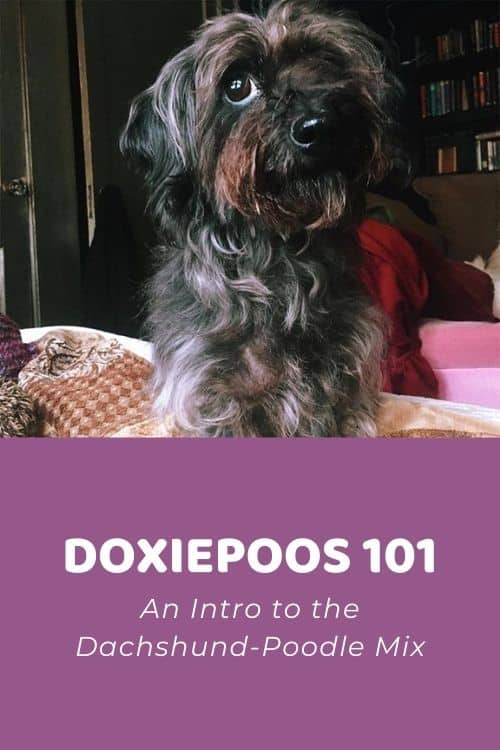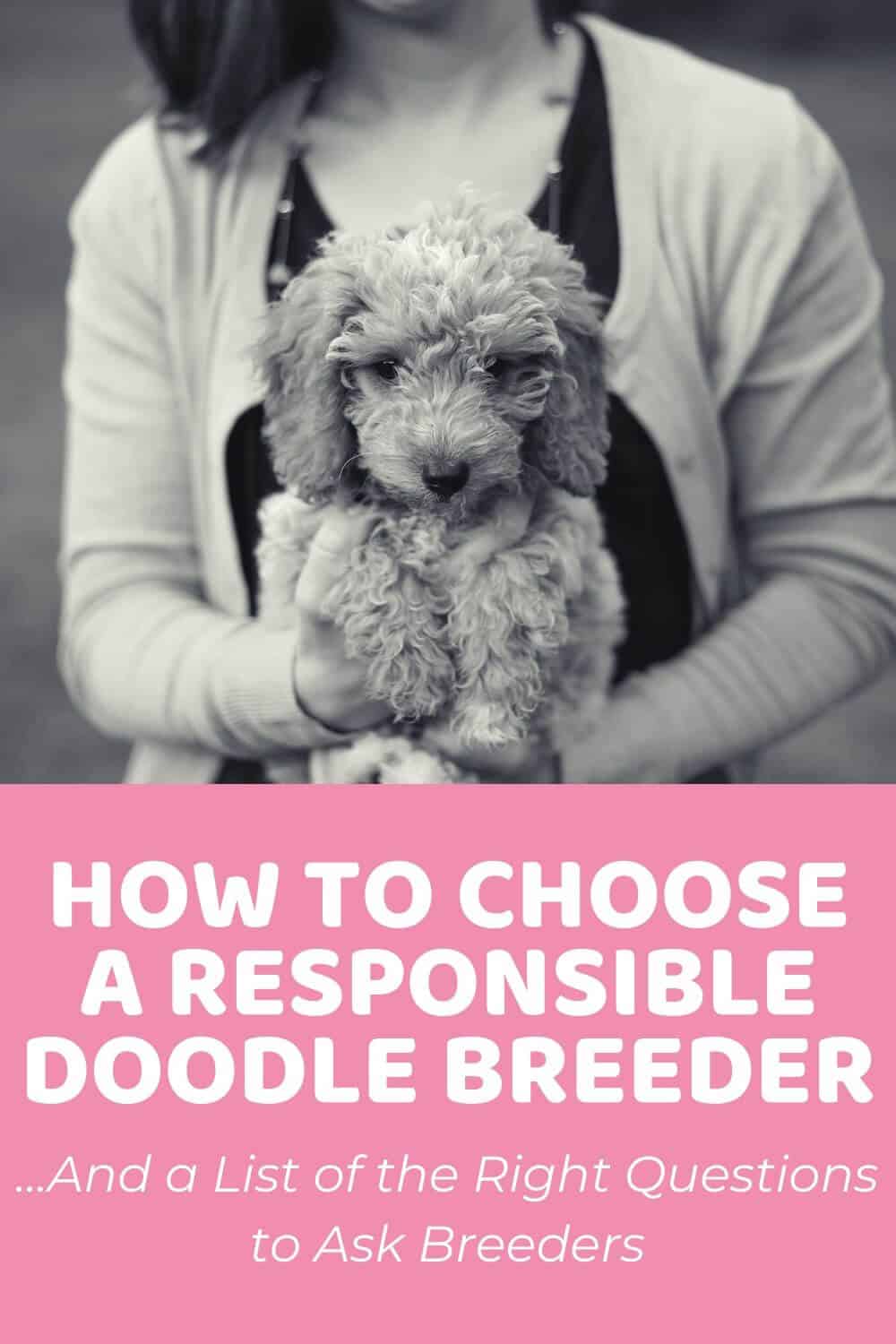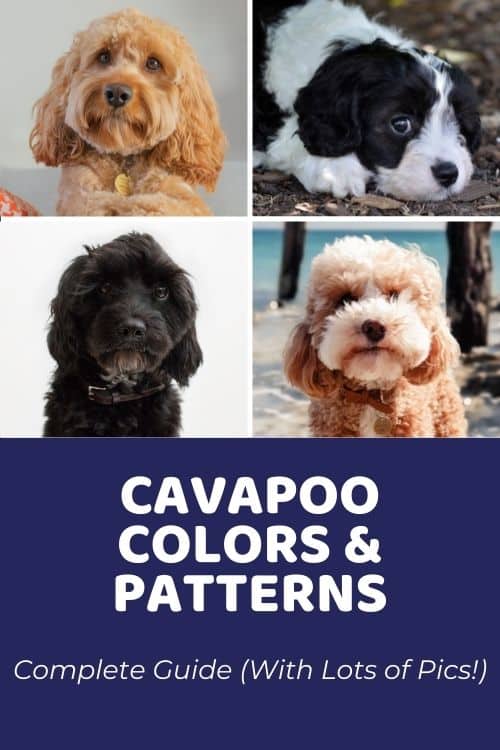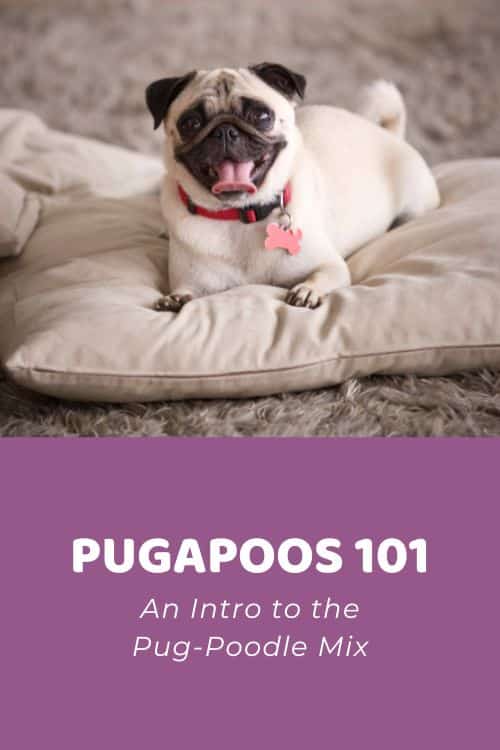Spirited, self-confident Doxiepoos are an excellent combination of the funky, friendly Dachshund and the smart, sophisticated Poodle. While relatively unknown except to the initiated few, Doxiepoos are darling little doods who bring a lot of love, laughter, and fun to the homes of the people lucky enough to adopt them.
If the mere thought of welcoming one of these charming chaps or chapesses into your family has you immediately running for the door, take a beat. While the idea of bringing home a Doxie might be appealing – it’s important to consider just what you will be getting yourself in for if you do take on one of these little loves. Let’s take a look.
Table of Contents
- What Exactly is a Doxiepoo?
- 3 Interesting Facts About Doxiepoos
- Physical Appearance
- Doxiepoo Pictures
- Doxiepoo Size
- Personality & Temperament
- Doxiepoo Variations & Generations
- Doxiepoo Health
- Exercise & Training
- Doxiepoo Coat & Grooming
- Where Can You Get Doxiepoo Puppies?
- Doxiepoo Frequently Asked Questions
Learn How to Care for Your Doodle Puppy!

Perfect for first-time Doodle parents, get ALL your questions answered, including questions new Doodle parents don’t even think to ask.
Plus, get $700 worth of Bonus Materials for FREE, including:- Doodle Parenthood Community and Support Group ($190 value)
- Doodle Puppy Growth Tracker ($20 value)
- EMERGENCY Cheatsheet: When To Call The Vet Immediately ($50 value)
- HELP! Button ($145 value)
- And SO MUCH MORE!
What Exactly is a Doxiepoo?
Playful and mischievous, Doxiepoos make perfect pets for active individuals. However, with that cunning, cheeky nature of theirs, you are going to need to keep a pretty close watch on them, especially in those first few years, to ensure they stay out of trouble.
Most of what we know about these relatively new-to-the-scene Doodles is taken from our understanding of the two parent dogs. We still have so much to learn about these little bundles of fun. So, to start off, let’s take a look at the breeds that went into creating them.
Dachshund
Also known as weiner dogs, sausage dogs, and badger dogs, Dachshunds are unique in their larger-dog-with-littler-legs appearance. Originally bred in Germany for hunting badgers, foxes, boar, and more, as you can imagine, these early ‘hunds’ varied considerably in size. However, today’s version, kept as pets rather than working animals, fits firmly into the lapdog category despite being bred in both Standard (8 to 9 inches tall and 16 to 32 pounds) and Miniature (5 to 6 inches tall and 11 pounds and under) sizes. Both make popular pets.
Poodles
Poodles, also from Germany, are another example of a dog breed used in hunting. However, rather than taking on the animals themselves, these dogs would retrieve the game shot down by their hunter masters. As word of their good looks and intelligence spread, Poodles became favorite parlor dogs in the royal courts of Europe. Like the Dachshund, they were bred in ever smaller sizes. These days you will find the original Standard Poodles, Miniature Poodles, and even Toy Poodles. Each has their own charms, and all make fabulous companion animals.
3 Interesting Facts About Doxiepoos
- Doxiepoos can vary quite wildly in terms of their size because not only are there different varieties of Poodle, but Dachshund too.
- While the Doxie’s parent breeds are startlingly different in terms of their appearance, they actually have a pretty similar background, both coming from Germany and both being hunting dogs.
- Dachshunds also have a variety of different coat types ranging from short to long, smooth to wiry. Some shed far more than others. With a Doxie, you really are getting a could-be-anything kind of dog!
Physical Appearance
Doxiepoos are more of the one unpredictable of the Doodles mixes. Not only are the creating breeds as distinct as dogs can get, but Doxies are also very much the new Doodles on the block. Puppies available tend to be first-generation (see below). And with one parent of each kind, the result could be just about anything. You might see the Dachshund’s long body covered in Poodle curls or the Poodle’s more athletic build with Dachshund fur – or something that sits somewhere between the two extremes.

Typically though, these dogs tend to have round heads with a muzzle that is well proportioned for their face and the trademark drooping ears of the Doodles. Their bodies are sturdy, and their coat colors range from black to white to cream but also include grey and brown. They might have a black or brown nose and could have typical brown canine eyes, or they might inherit the rarer hazel ones that can sometimes be seen in red-hued Dachshunds.
Doxiepoo Pictures
Simply click on the links below to view photos of the Doxiepoos.
| Photo Link | |
| Black and Tan Doxiepoo | @masakanaron_miu |
| Black and Tan Doxiepoo | @mahaloha_cuta |
| Brown Doxiepoo | @littlemia_bigworld |
| Golden Doxiepoo | @dachpoo_cocoa |
Doxiepoo Size
As mentioned above, both Dachshunds and Poodles come in varying sizes, meaning your Doxie might be classified as a small or a midsize dog. However, given the Dach’s more diminutive stature, Miniature Poodles are typically the ones used in the pairing. Sometimes breeders might aim for more miniature puppies by using the Toy, but the Standard doesn’t feature here at all.
Despite that, unlike most all other Doodles, Doxiepoos are currently only categorized into a single size. Confusingly this is Standard. However, they can range in weight from a teeny 5 to 30 pounds and height from 8 to 21 inches. Doxies are thought to reach their mature size somewhere around 7.5 to 13 months, with the smaller-sized pups getting there first.
If you’re looking to get a better understanding of exactly where your puppy is likely to sit on this scale once they reach adulthood, then the best thing you can do is speak to the breeder. They will be able to fill you in on the type and size of the parent dogs, which will provide a much clearer indication of what you might expect from your dog. Either way, you’re going to end up with an apartment-suitable dog, so don’t worry about that.
Personality & Temperament
Doxiepoos make fun and entertaining companions to singles or families with plenty of dog experience. These aren’t the best pups for novice owners. One reason is that some of their natural instincts aren’t always best suited for living harmoniously with others. For instance, these guys and gals make extremely vigilant watchdogs, which does make them somewhat prone to yappiness. If not corrected early, this behavior won’t make them too popular with the neighbors.
As well as that, the Doxies’ high prey drive, which they inherit from their working dog ancestors, means they don’t always do so well around other pets. They will take great delight in chasing anything smaller than them around. Doxiepoos also tend to be hyper-competitive with other dogs. For these reasons, they do best in single-pet households. That being said, they can learn to get along with other pets if they are socialized to do so from a very young age.
While Doxies aren’t the family-friendly pups that say Goldendoodles are, they tolerate children pretty well. However, as smaller pups, they stand the risk of getting injured if the play becomes too rough. They might also get scared, which could prompt them to lash out. Any kid-dog time should always be closely supervised. Teaching your children how to behave appropriately around dogs to avoid serious issues is also a good idea.
Probably the biggest concern with Doxiepoos is that they really don’t like being left alone. They are incredibly loving, affectionate dogs who thrive under the loving care of their family. Your archetypical little dogs with big-dog personalities, Doxies have a lot to offer. Still, you will want to rethink your plans to adopt one of these magnificent mutts if you and your family are gone for much of the day. Separation anxiety is a real problem and could cause your new pet to exhibit some very undesirable behaviors.
Doxiepoo Variations & Generations
Purchasing a Doodle can end up being all kinds of confusing when you’re not just confronted with different size options, but people start talking about generations too. In this instance, they are referring to whether the parent dogs are pedigrees or Doodles themselves and what this means in terms of the genes your puppy has ended up with.
Below are the possible combinations for Doxiepoos:
| 1st Parent | 2nd Parent | % Dachshund* | % Poodle* | |
| F1 Doxiepoo (first-generation) | Dachshund | Poodle | 50% | 50% |
| F1B Doxiepoo (first-generation backcross) | F1 Doxiepoo | Poodle | 25% | 75% |
| F1BB Doxiepoo (first-generation backcross backcross) | F1B Doxiepoo | Poodle | 12.5% | 87.5% |
| F2 Doxiepoo (second-generation) | F1 Doxiepoo | F1 Doxiepoo | 50% | 50% |
| F2B Doxiepoo (second-generation backcross) | F1 Doxiepoo | F1B Doxiepoo | 37.5% | 62.5% |
| F2B Doxiepoo (alternate cross) | F2 Doxiepoo | Poodle | 25% | 75% |
| F3 / Multigen Doxiepoo | F1B Doxiepoo or higher | F1B Doxiepoo or higher | Varies | Varies |

As touched on above, Doxiepoos are relatively recent doods, which means that you are more likely to find first-generation pups only at this time. However, if they continue on the same track as other popular types, the possibilities for these dogs are virtually endless.
Doxiepoo Health
As smaller dogs, Doxiepoos enjoy longer lifespans. You might expect your pet to be around somewhere in the region of 12 to 15 years – more with proper care and attention.
The genetic diversity that comes with mixing two breeds also works in the Doxie’s favor regarding their health. However, they are still open to a few genetic conditions – and far fewer if you get them from a quality breeder. Either way, a few things to be on the lookout for are:
- Intervertebral Disc Disease – a degenerative condition that impacts the spine. Common symptoms are obvious pain in the back and neck area.
- Hip dysplasia – an issue of the hip joint whereby the ball and socket rub and grind instead of gliding smoothly. This can severely impact movement.
- Gastric Dilations Volvulus – otherwise known as bloat. Gas collects in the stomach and can cause it to twist back on itself, blocking the entrance and exit.
- Addison’s Disease – a decrease in hormone production that can cause lethargy, gastrointestinal issues, increased urination, and weight loss.
- Ear Infections – frequently seen in long-eared dogs, especially when the ears are very hairy. Infections can be either bacterial or fungal. Both are easily treated.
- Allergies – Poodles as a breed are sensitive to certain foods and ingredients found in products such as shampoos. Signs can include skin itchy and diarrhea.
Aside from these, Doxiepoos have a lot of potential for weight gain, especially if they aren’t getting enough exercise (see below). Be careful with what and how much you feed your four-legged friend. Obesity is a common problem in canines and can cause or exacerbate many health issues.
Exercise & Training
While Poodles are notoriously easy to train, Dachshunds tend to have a bit of a stubborn streak. They could easily pass this on to their offspring. If this is the case, you will need an established method for motivating them. This is one of the reasons we recommend these pups for more experienced owners. Positive reinforcement should work well enough as long as you keep things fun, fair, and engaging. The Doxie’s people-pleasing nature should win out in the end.
Start early with training, as with socialization, and work at it every single day. Check out Baxter and Bella’s Online Puppy School for valuable tips and tricks. A further benefit of regular training sessions is that they help keep your Doxie mentally focused. This is essential for these super smart hounds. No matter how well-trained your dog is, never let them off the leash outside a well-secured area. With their hunting background and high prey drive, one whiff of a squirrel, and they’ll be off!
In terms of exercise, Doxiepoos tend to have relatively high energy levels and can be very playful pups indeed. So you will be looking at at least one hour of dedicated daily walk time. It’s better if this is broken down into two or three times a day to give your pal something to look forward to. Between this, you will likely find yourself playing tug-of-war games and throwing the ball down the garden for your pet. As athletic dogs, Doxies do well with canine sports if that is something that interests you.
Doxiepoo Coat & Grooming
The promise of a low-shed, ‘hypoallergenic’ Doodle coat is likely to be a strong draw for the people who consider homing a Doxiepoo. That being said, Doodles are coming into their own in terms of popularity as people are beginning to recognize what fantastic all-around pets they make over and beyond the advantages of their coat.
This is great because that curly Poodle single-layered hair is not a given with these dogs. It all depends on what they end up getting passed down by the parent breeds. In the case of the Doxie, the Poodle hair is a possibility, but so too are the three different coat types of the Dachshund: smooth, long, and wire-haired.
The smooth coat is the most common. Like the Poodle one, it’s single-layered and low-shed. The same is true of the long coat. However, the wire-haired one is double-layered, so these dogs tend to molt much more than their counterparts. Any which way, if your Doxie gets a Dachshund coat, you can breathe a sigh of relief that it will require much less care than the long Poodle one, which is a magnet for dirt, debris, and tangles and requires daily brushing.
Whatever the case, coat care is something that you will need to dedicate regular time to. This is especially true if you plan to deal with it at home rather than sending your dog out to the groomers. As part of this, you will need to clean your pet’s ears, check their paws, and trim their coat (particularly around their face and tail). You may even need to express their anal glands.
Want to Learn
DIY Doodle Grooming?
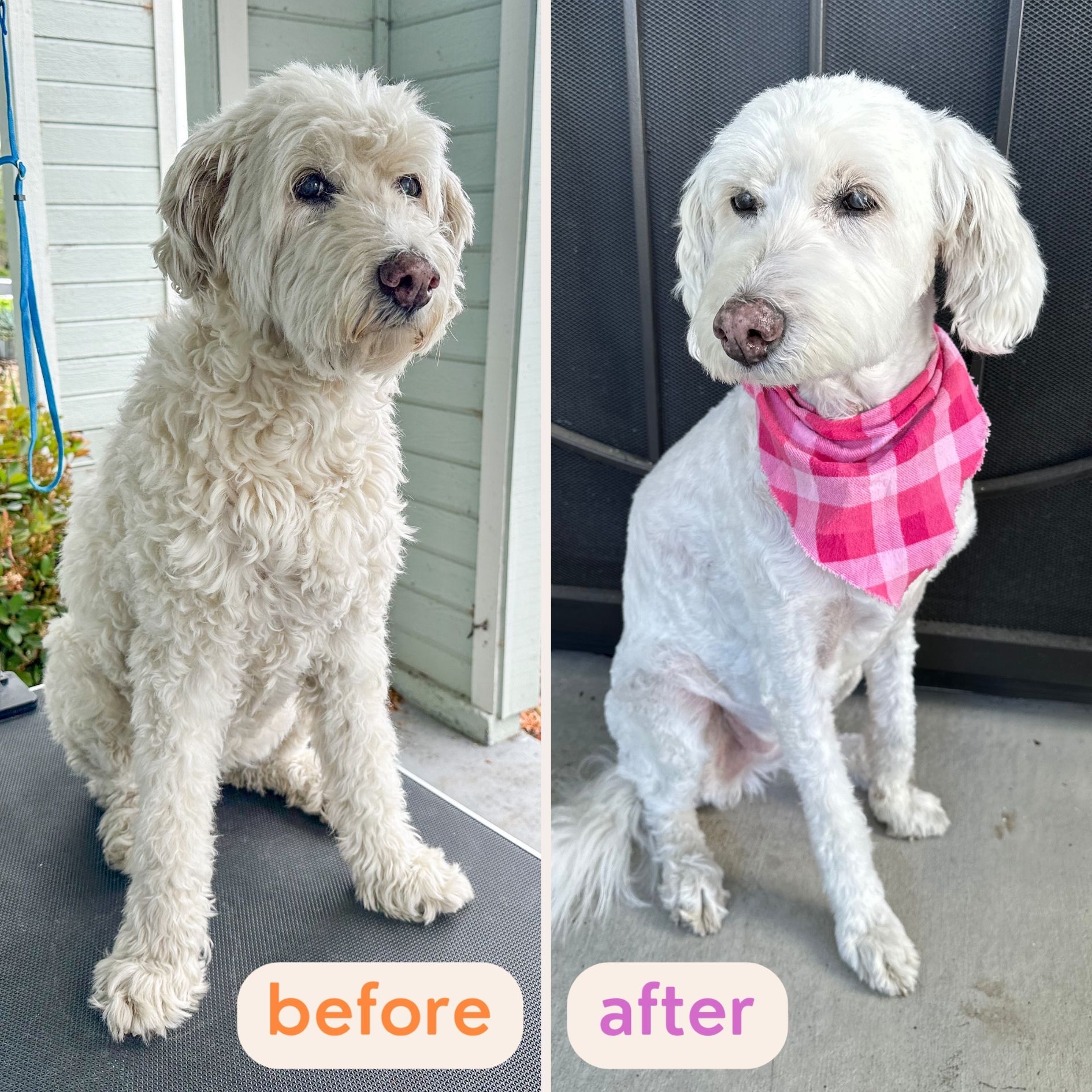
 “Every concern and question I had now has clear, practical solutions.” – Paula D.
“Every concern and question I had now has clear, practical solutions.” – Paula D.
 “These lessons have provided tremendous amounts of information.” – Steve B.
“These lessons have provided tremendous amounts of information.” – Steve B.
 “Buy the course and complain about how easy it is!” – Chris S.
“Buy the course and complain about how easy it is!” – Chris S.
Learn How To Groom Your Doodle At Home…
Safely…And Without Confusion:
Where Can You Get Doxiepoo Puppies?
Doxiepoo puppies might be a little harder to track down than Labradoodles or Cockapoos. This could either be a good or a bad thing in terms of their price. Some breeders will charge more for their scarcity and others less because of their lack of popularity. A quick web search will show you that you could be looking at spending anywhere between $250 and $2000 on a Doxiepoo.
However, you’ll want to be cautious of any breeders offering these dogs at exceptionally lower-than-average prices. This is generally a warning sign of either a scam or a puppy mill at work. The former will try to con you out of a down payment without any evidence of having puppies. The latter will have puppies, but as their focus will be on turning a profit over the wellbeing of their dogs, they won’t be very healthy animals at all.
In searching out a reputable breeder of Doxiepoos, check expert sites, social media reviews, and take advice from those who have purchased such puppies. Our very own breeder directory is a great place to start with getting names of places in your local area. Beyond that, it pays to search the name of the breeders you are considering on various animal welfare sites such as The Humane Society’s website. This will help you determine their quality.
Doxiepoo Frequently Asked Questions
As mixed breed dogs and relatively new ones at that, Doxiepoos don’t have any specific defining characteristics. They could inherit the larger-than-life, loving, quick, slightly stubborn nature of the Dachshund. Equally likely, they could end up with the Poodle’s intelligent, comical, loyal, sometimes standoffish personality. Alternatively, they may sit somewhere in between. The same goes for their appearance – anything goes.
The size range for the Doxiepoo sits within the parameters of the small to medium dog size. That being said, it does range quite a bit at 5 to 30 pounds in weight and 8 to 21 inches to the shoulder in height. The best way to determine your puppy’s mature height and weight is to ask the breeder about the size of the parent dogs.
Doxiedoodle is simply another name given to the lovely Dachshund-Poodle mix. Others include Dachdoodle, Doxiepoodle, Dachshundoodle, and Dachshundpoo. Doxiepoo is the most common one, likely because it is the simplest to say. You don’t have to stagger your way through the pronunciation of the mysterious Dachshund letter combination.
Doxiedoodles are incredibly cute dogs that, at this point, not many people have even heard of. This has both advantages and disadvantages if you are looking to adopt one of these friendly Fidos. Firstly, they might be a little tough to get your hands on, but could well be cheaper than other Doodles when you do. Secondly, there are no specific standards in terms of either appearance or personality, so your dog will be totally unique and an absolute surprise. Finally, if you do end up bringing one into your life and your home, you’ll be the envy of all your friends and neighbors (just as long as you’ve got a handle on training and your fur-baby doesn’t take it in their head to keep them up by barking through the night).

